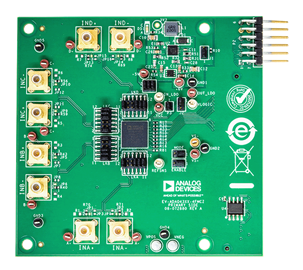Overview
Features and Benefits
- ADAQ4370-4 quad, 16-bit, 4/2 MSPS, μModule® evaluation boards
- Versatile analog signal conditioning circuitry
- On-board LDO and power supply circuits
- PC software for control and data analysis of time and frequency domain
- System demonstration platform-compatible (SDP-H1, high-speed controller board (EVAL-SDP-CH1Z))
Product Details
The EV-ADAQ4380-4FMCZ and EV-ADAQ4370-4FMCZ evaluation boards (see Figure 1) enable a simple evaluation of the ADAQ4380-4 and ADAQ4370-4 quad, 16-bit, 4/2 MSPS, simultaneous sampling, μModule data acquisition solutions, respectively. The evaluation boards demonstrate the performance of the ADAQ4380-4 and ADAQ4370-4 μModules and are versatile tools for variety of applications.
The ADAQ4380-4 and ADAQ4370-4 μModules combine multiple common signal processing and conditioning blocks into a single device that includes a low noise, fully differential analog-to-digital converter (ADC) drivers, a high precision 3.3 V reference chip, low-noise reference buffer, high resolution, quad, 16-bit, 4/2 MSPS simultaneous sampling successive approximation register (SAR) ADC, and all the critical passive components necessary for optimum performance.
The EV-ADAQ4380-4FMCZ and EV-ADAQ4370-4FMCZ evaluation boards interface with high-speed system demonstration platform SDP-H1 (EVAL-SDP-CH1Z) board through a 160-pin FMC connector, as shown in Figure 2.
Refer to the ADAQ4380-4 and ADAQ4370-4 data sheets for full specifications, which must be consulted in conjunction with this user guide when using the EV-ADAQ4380-4FMCZ and EVADAQ4370- 4FMCZ evaluation boards. For the current schematic, layouts, and bill of materials, refer to the EVAL-ADAQ4380-4 or EVAL-ADAQ4370-4 product page.
Markets and Technologies
Applicable Parts
Getting Started
- PC running Windows® 10 or higher
- SDP-H1 (EVAL-SDP-CH1Z) controller board
- Low noise, precision signal source (such as APX500 series)
- Standard USB A to USB mini-B
- Band-pass filter suitable for 16-bit testing (optional, value based on signal frequency)
Documentation & Resources
-
EVAL-ADAQ4370-4 Design Files10/29/2024ZIP3 M





